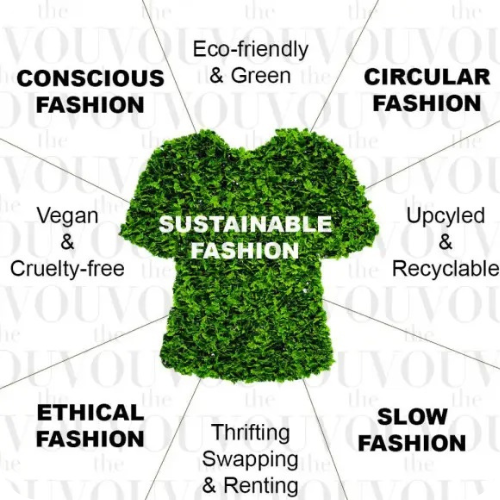Sustainable fashion is not just a trend; it represents a significant shift in how we perceive clothing and its impact on the environment. As consumers become increasingly aware of the ethical implications of their purchases, the demand for sustainable and ethical clothing continues to rise. This article delves into the concept of sustainable fashion, exploring its core principles, including eco-friendly materials, ethical production practices, and the importance of transparency in the fashion industry. By understanding these elements, we can make informed choices that contribute to a more sustainable future.
In the following sections, we will examine the various aspects of sustainable fashion, including the innovative materials that are reshaping the industry, such as organic cotton, recycled fabrics, and biodegradable textiles. We will also discuss the role of ethical brands that prioritize fair labor practices and environmental stewardship. Furthermore, we will highlight the impact of consumer behavior on the fashion ecosystem and how small changes in our purchasing habits can lead to significant positive outcomes.
Join us on this journey to discover how sustainable fashion is paving the way for a more ethical clothing industry. Whether you are a fashion enthusiast or simply curious about making more responsible choices, this article will provide valuable insights and practical tips to help you navigate the world of sustainable fashion. Read on to learn how you can be a part of this transformative movement and contribute to a healthier planet.
Sustainable fashion is not just a trend; it represents a significant shift in the way we think about clothing and its impact on the environment. As consumers become more aware of the ethical implications of their purchases, the demand for sustainable and ethical clothing continues to rise. This article explores key aspects of sustainable fashion that are shaping its future.
Sustainable Materials: The Backbone of Ethical Clothing
The choice of materials is crucial in sustainable fashion. Traditional fabrics like cotton and polyester often involve harmful farming practices and significant water usage. In contrast, sustainable materials such as organic cotton, Tencel, and recycled polyester are gaining popularity. These materials not only reduce environmental impact but also promote better working conditions for farmers and workers.
Moreover, innovative materials like hemp and bamboo are emerging as eco-friendly alternatives. Hemp, for instance, requires less water and no pesticides, making it a sustainable choice. As brands increasingly adopt these materials, consumers can make informed choices that align with their values, supporting a more sustainable fashion industry.
The Role of Ethical Labor Practices
Ethical labor practices are a cornerstone of sustainable fashion. Many fast fashion brands exploit cheap labor in developing countries, leading to poor working conditions and unfair wages. In contrast, sustainable fashion brands prioritize fair trade practices, ensuring that workers receive fair compensation and work in safe environments.
By supporting brands that adhere to ethical labor standards, consumers can contribute to a more equitable fashion industry. Certifications such as Fair Trade and GOTS (Global Organic Textile Standard) help consumers identify brands that prioritize ethical practices, fostering a culture of transparency and accountability in the fashion world.
Consumer Awareness and the Rise of Second-Hand Shopping
As awareness of the environmental impact of fashion grows, more consumers are turning to second-hand shopping as a sustainable alternative. Thrift stores, online resale platforms, and clothing swaps are becoming increasingly popular, allowing consumers to extend the life cycle of garments and reduce waste.
This shift not only promotes sustainability but also encourages creativity and individuality in fashion choices. By embracing second-hand shopping, consumers can find unique pieces while contributing to a circular economy that values reuse and recycling over fast fashion consumption.
Technological Innovations in Sustainable Fashion
Technology plays a pivotal role in the evolution of sustainable fashion. Innovations such as 3D printing, digital fashion design, and blockchain for supply chain transparency are transforming the industry. 3D printing, for example, allows for on-demand production, reducing waste associated with overproduction.
Additionally, blockchain technology can enhance transparency in the supply chain, enabling consumers to trace the origins of their clothing. As these technologies become more accessible, they hold the potential to revolutionize the fashion industry, making it more sustainable and ethical.
The Future of Sustainable Fashion: Trends to Watch
The future of sustainable fashion is bright, with several trends emerging that promise to reshape the industry. From the increasing popularity of rental services to the rise of eco-conscious influencers, consumers are becoming more engaged in sustainable practices. Brands are also focusing on transparency, sharing their sustainability efforts and progress with consumers.
As sustainability becomes a priority for both consumers and brands, the fashion industry is likely to see a shift towards more responsible practices. This evolution not only benefits the environment but also fosters a culture of ethical consumption, paving the way for a more sustainable future in fashion.
| Aspect | Description |
|---|---|
| Definition | Sustainable fashion refers to clothing that is designed, manufactured, and marketed in a way that is environmentally friendly and socially responsible. |
| Environmental Impact | The fashion industry is one of the largest polluters. Sustainable fashion aims to reduce waste, lower carbon emissions, and minimize water usage. |
| Ethical Production | Focuses on fair labor practices, ensuring that workers are paid fairly and work in safe conditions. |
| Materials | Utilizes organic, recycled, or upcycled materials to reduce the environmental footprint of clothing production. |
| Consumer Awareness | Encourages consumers to make informed choices about their clothing purchases, promoting a shift towards sustainable brands. |
| Innovations | Incorporates new technologies and practices, such as 3D printing and biodegradable fabrics, to enhance sustainability. |
| Future Trends | Predictions indicate a growing demand for transparency in supply chains and an increase in second-hand and rental clothing markets. |
| Conclusion | Sustainable fashion represents a necessary shift towards a more ethical and environmentally friendly clothing industry, with the potential to reshape consumer habits and industry standards. |

